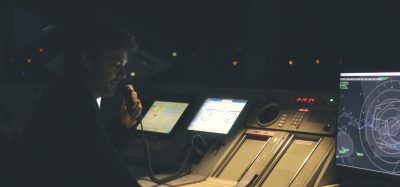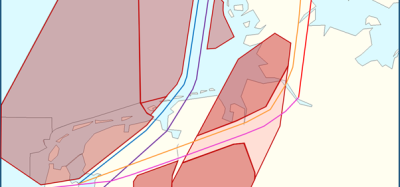Cooperating on ATM research
- Like
- Digg
- Del
- Tumblr
- VKontakte
- Buffer
- Love This
- Odnoklassniki
- Meneame
- Blogger
- Amazon
- Yahoo Mail
- Gmail
- AOL
- Newsvine
- HackerNews
- Evernote
- MySpace
- Mail.ru
- Viadeo
- Line
- Comments
- Yummly
- SMS
- Viber
- Telegram
- Subscribe
- Skype
- Facebook Messenger
- Kakao
- LiveJournal
- Yammer
- Edgar
- Fintel
- Mix
- Instapaper
- Copy Link
Posted: 16 September 2005 | Hans Offerman, Chairman EATRADA European Air Traffic Management Research and Development Association | No comments yet
The most effective way of researching new technologies needed to enhance capacity is to work together writes Hans Offerman, chairman of a new European association with cooperative aims.
The most effective way of researching new technologies needed to enhance capacity is to work together writes Hans Offerman, chairman of a new European association with cooperative aims.
The European Air Traffic Management Research and Development Association, or EATRADA, is a recently created association to help promote an effective ATM R&D capability in Europe. Essentially this is our mission, but it also reflects our ambition; the association is very much aware of the enormous task that lies in front of the air transport community to implement the Single European Sky. Research and Development is an essential part of this process. Without the proper level of R&D experience and knowledge to call upon, the implementation of many improvements still to come would be jeopardized.
While in other parts of the world ATM R&D tends to be much more geographically concentrated in a limited number of institutes, in Europe there are many private or government-owned ATM R&D institutes as well as R&D divisions at the majority of Air Navigation Service Providers (ANSPs). See this in combination with the Eurocontrol Experimental Centre in France and one can only say that there is need for closer co-operation in Europe.
Political changes
As an ATM community we have witnessed some significant changes in the last decade. The European Commission (EC) inaugurated the Advisory Council for Aeronautics Research in Europe (ACARE) which published its view in two Strategic Research Agenda’s to provide direction for R&D. The system-wide approach to the air transport evolution forms a strong requirement for the ATM component in the system. Another change was the accession of the EC to the Eurocontrol Convention. ATM R&D is covered in the Memorandum of Cooperation between the parties. This strong connection is one of the drivers enabling the development of the European ATM Master Plan in the SESAME project.
When combined with a tendency to decrease the national efforts by individual member states developing their own ATM system, one can conclude that a more focused European R&D is necessary to guarantee a coherent system.
Open membership
EATRADA is an open association. Currently its members are DFS , NATS, DGAC (DTI/SDER), QinetiQ, DLR, Sofréavia, ISDEFE, INECO, SICTA and NLR. AENA and the Eurocontrol Experimental Centre are currently joining and when that happens, EATRADA has on board almost all of the major players of the ATM R&D scene in Europe. Although open to Universities with a clear capability in ATM R&D, the association has of yet no representatives from this part of the community.
The association is still young and not yet fully matured in its mission to promote R&D results, but the association is already recognised as providing added value to several institutions. EATRADA has a seat in the Eurocontrol ATM Consultation Group (ACG) and provides assistance as observer in the European Commission’s Industry Consultation Body (ICB).
The ATM system of the future is still unclear. It is not known which concepts will be made available for implementation, but speculation is rife. For this reason it is crucial that the SESAME definition phase aligns all stakeholders in the same direction. The discussion during this phase will not be about R&D, but about the reach for goals dictated by the higher level system requirements. But our R&D expertise and means to validate ideas and concepts before actually being frozen in the design will form a critical success factor.
Pacing change
It is evident that the future ATM system will change significantly from what it is today. When will the often heard ‘paradigm change’ happen though? However we’re not even sure what exactly is meant by this term. It is possible to say though that there will be a shift from a labour and data intensive ATM system to a knowledge-based system that optimises the performance of available resources. Most probably one can expect a gradual and stepwise change in the controlling mechanism, from ground-based to cockpit-based. The air traffic controller will become an air traffic manager; the same change as happened in the cockpit: from controlling the aircraft to managing the flight process.
This is easily said, but less easily implemented. Every change in the level of responsibility of the air traffic controller or pilot, no matter how small, must be validated. It is not merely an increase in automation or adding technology. It requires another way of thinking and thus preparing both the ground and airborne community in accepting these changes. Air traffic controllers and pilots are conservative people when it comes to changes because their primary responsibility is executing a safe operation. This is exactly the reason that the air transport sector has such high safety levels compared to other modes of transport.
The air transport industry is committed to keeping safety levels at present levels in the future. Demand is also expected to increase significantly, along with a strong pressure to increase overall system efficiency at less cost. This implies that internal process safety levels have to be raised. After a few years of relative rest (“9-11”, SARS), capacity walls are nearing again with the lingering prospect of severe delays. Mere improvements to the existing ATM system will not deliver the capacity and sustainability requested in the long term.
New concepts
So, new concepts of operation are needed to guarantee safety and security, efficiency and environmental requirements. It is exactly these goals to which EATRADA members are committed to. An important aspect to consider is that all elements of the air transport value chain are addressed and that a total system optimisation is carried out. Various stakeholders like the airport, ground handling, ANSPs and airlines have hard economical interests which need to be addressed, related to the short term lifecycle in which these players act. But short term and solid R&D are incompatible. All the more reason why then it is essential that EATRADA can ensure that the longer term issues are addressed in time.
It remains vital to address short term problems though, for example the development of methods to prevent runway incursions. Both industry and the R&D community have been working hard to define and implement the first stages of what is needed in an Advanced Surface Movement Guidance and Control System (A-SMGCS). At present several techniques exist to create traffic awareness at an airport, ranging from using surface movement radars or multilateration to the more active ADS-B. The next stage is to use this data to provide guidelines for ATC staff.
Interpreting traffic movements to ascertain when a possible hazardous situation may arise is a challenge. However extensive research on criteria, operational procedures and system requirements has led to the situation that many airports are now using first or second generation runway incursion alerting systems. Extending these systems with advanced planning modules that make use of cognitive technologies to make more efficient and effective use of airport assets will be the focus of future R&D.
Funding
Financing the research carried out by the air transport and ATM industry depends on the timescale of the research output. The above mentioned runway incursion alerting systems are in many cases financed by the ANSP or the airport in need for the system. In this example deployment of R&D to a ‘local’ implementation directly links to daily operational business.
Middle and long term research is more linked to National, Eurocontrol and EC financed projects. In these projects a strong multi-national or global approach is taken to make sure that standards and systems are developed, introduced and accepted by the entire industry.
These European scale projects have the possibility to research new operational concepts which is crucial in simultaneously expanding capacity and preserving safety levels. Major steps are being made in several areas, for example addressing the bottlenecks in the airport. It has becomes apparent from the recent EC reports that the current increase of new airports or the amount of runways on existing airports does not meet the anticipated trend of capacity demand increases of 4-5 per cent annually. Much of the R&D conducted is linked to this problem.
The airport problem
An important issue in tackling the ‘airport problem’ is the challenge of transforming the airport with its local requirements into a larger context; Total Airport Management. It integrates and links all services and operations in its broadest sense. New means of Collaborative Decision Making beyond current levels of information sharing is also required. There is strong need to reduce the variability in airport processes to fulfill passenger requirements in terms of punctuality, connectivity and comfort. We’ll have to step back from the gate-to-gate approach and step up to a (passenger) door-to-door mindset. Many projects initiated by the industry, Eurocontrol and the Commission tackle this changed approach step-by-step.
But it is not only information sharing which needs to be addressed. An important factor limiting today’s airport capacity is the phenomenon of wake vortices generated by aircraft in flight. To avoid aircraft entering the zone of turbulence of another aircraft during the approach phase, minimum separation criteria between aircraft were published in the 1970’s. These separations are expressed in terms of longitudinal distances and have since served to provide acceptable safe separations between aircraft at all major airports through the use of radar.
An integrated Air Traffic Control (ATC) wake vortex safety and capacity system used in combination with new modified wake vortex safety regulation is expected to provide the means to significantly enhance airport capacity. The main objective of one of these projects, the ATC-wake project, is to develop and build an innovative platform integrated into the air traffic control systems with the aim of optimising safety and capacity.
Projects initiated and co-financed by the European Commission have increased the overall confidence substantiating this. Specially equipped research aircraft trailing an Airbus A-340 for instance, equipped with a forward looking LIDAR (a radar with a laser) crossed wake vortex paths to measure vortex strength and structure. The A-340 flew various configurations to make sure that normal operating conditions were mimicked to investigate the hazards of separation distance variations used during final approach or departure.
From these in-flight measurements validated mathematical models of wake vortices can be constructed. By having a validated model available one can research conditions which cannot easily be recreated in real life at the touch of a button. Effects of different atmospheric conditions like strong crosswind conditions have a significant impact on the travel and dissipation of a wake vortex behind an aircraft. With actual measurements from ground-based and or airborne systems and the model information a decision support system can be constructed.
This is absolutely crucial to pilot and air traffic controller to accept decreased separation minima. In turn it allows for a safe increase in airport capacity. Both tactically; increase in runway capacity and strategically; improvement in airline schedule planning. The local installation of an integrated system at European airports will require new safety regulation, since the present wake vortex safety recommendations and best practices do not take new modified ATC systems into account. Specific attention will be given to the issue of development and harmonisation of new wake vortex safety regulation.
In these projects industry, air navigation service providers, Eurocontrol and research parties work closely together to ensure that efforts are focused to provide results.
Technology breakthroughs
This will eventually lead to the local installation of an integrated system at European airports which will require new safety regulation, since the present wake vortex safety recommendations and best practices do not take new modified ATC systems into account. Specific attention will be given to the issue of development and harmonisation of new wake vortex safety regulation. In these projects industry, ANSPs, Eurocontrol and research parties closely work together to make sure efforts are focused to provide results.
Many more technology breakthroughs could be mentioned here. However, an important point is that R&D is not just about new technology, but brings expertise in applying and validating technologies for use in the ATM domain. The research organisations participating in EATRADA in many cases have their own specific R&D focus. Some have detailed expertise and experience with flight data processing, airspace and airport design or implementing air traffic controller support tools. Others are focused on safety methodology, designing noise abatement procedures or human factor issues. Increasingly, one can see that these expertises are combined in projects with clear implementation goals. Also much of the work performed in the past was very much linked to the local airports and ANSPs. A change to a European and even global approach in providing solutions has become quite visible in the last decade. A large knowledge base, expertise and research and validation facility infrastructure is available to the ATM community.
EATRADA welcomes interested parties to join the association. Notwithstanding the ‘E’ in EATRADA, the association recognises that ATM is a global challenge and hence partnerships with U.S., Asian, Australian parties or global representative bodies will be sought in the very near future.
With EATRADA acting as the overall (European) representative body we are able to contribute to technical excellence and a harmonised and coordinated research and development capability. Major hurdles have to be taken to change the European ATM system through the Single European Sky initiative. A well structured and “prepared” R&D community is absolutely essential to leap over these hurdles.
Hans Offerman
Hans Offerman joined the National Aerospace Laboratory (NLR) in 1987 and in 2002 became manager of the Air Transport Division.
In his current position he is responsible for a division focused on air traffic management and airport technology development, safety assessments and safety methodology development, air-ground integration, the environmental impact of air transport and decision support systems.
Mr Offerman has participated in several national and international bodies and working groups, providing a professional opinion on ATM and related issues. He has been chairman of the European ATM R&D Association since 2004.


















